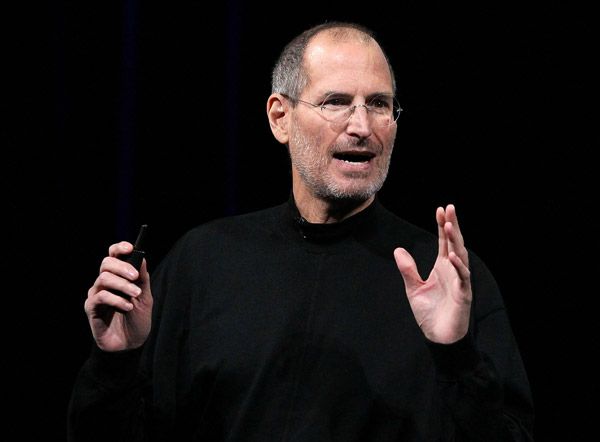Storytelling, as a leadership capability, can become the strong foundation of company culture. But just how can the power of narrative and storytelling help leaders to spearhead and activate change in their business? DQ Editor Sophia Watson explores the Apple case study, and how Steve Jobs used storytelling to lead his team.

January 13th, 2015
Great leaders are great storytellers. Yet in business, leaders often struggle to find a credible, compelling story to tell in times of uncertainty and changes in workplace culture.
People naturally resist change; it’s human nature, preferring to stay within their comfort zones and sticking to often-entrenched behaviors. To break through these resistance barriers and bring people with them, leaders need to foster a culture of collaboration, involvement, dialogue and consultation internally to build loyalty, trust and teamwork and retain talent. But to do this they need a good story to tell, a story of the business journey that everyone can understand and believe in, and a process through which they can personalise the story and deliver it in an authentic, meaningful way to their teams.
The most successful companies in the world use storytelling very intentionally as a leadership tool – think Microsoft, Nike, Apple, McDonalds and so on. The most tried-and-true method of corporate storytelling is of course appointing a high level corporate ‘storyteller’, who’s job it is to capture and share their most important company narratives.
Many companies invest serious capital in teaching storytelling to their executives. P&G for example has, in the past, hired Hollywood movie directors to teach its senior executives how to lead better with storytelling. And some of the storytellers at Motorola belong to outside improvisational or theatre groups to hone their story skills.
So why is this leadership method so valuable? Put very simply, you can’t just order people to “be more creative” or to “get motivated” or to “start loving your job.” The human brain doesn’t work that way. But you can lead them there with a good story.
It is difficult to think of a more powerful and successful corporate storyteller than the late Steve Jobs. Experts have associated the innovation at Apple with its corporate culture, and at the centre of it Jobs was a great leader because he used storytelling to improve the impact and uptake of Apple’s communications, and in the process, engage and align his employees around what they need to achieve and why it’s worth achieving.
Apple is one of those companies where people work on an almost religious level of commitment. Most workers, no matter how simple their job might be, truly feel they are changing the world with whatever they are doing. This is evident at any Apple Genius Bar, product launch day or even a simple iOS update. Why? Because Jobs understood the power of storytelling to influence, empower and persuade his people internally.
Jobs for example believed strongly in providing his team with knowledge to empower employees to “run their own show” and work in a challenging creative environment. Jobs often walked around the office barefoot even after Apple was a Fortune 500 company. By the time of the “1984” TV ad, this trait had become a key way the company attempted to differentiate itself from its competitors. According to a 2011 report in Fortune, this has resulted in a corporate culture more akin to a start-up rather than a multinational corporation.
As the company has grown and been led by a series of chief executives, each with his own idea of what Apple should be, some of its original character has arguably been lost, but Apple still has a reputation for fostering individuality and excellence that reliably draws talented people into its employ.
To this end, Apple employees are specialists who are not exposed to functions outside their area of expertise. Jobs saw this as a means of having “best-in-class” employees in every role where each project has a “directly responsible individual,” or “DRI” in Apple jargon.
To further solidify the culture of its company by recognizing the best of its people, Apple created the Apple Fellows program, awarding individuals who made extraordinary technical or leadership contributions to personal computing while at the company. What Apple is very successfully achieving here is activating the ‘characters’ and ‘heroes’ in its story, to ‘perform’ or ‘act-out’ a specific parts in the script where by all employees have narrative purpose.
However, as popular as storytelling has become, in a leadership capacity it’s about more than simply telling any story at any time. As a leader, it’s about telling the right story at the right time to intentionally shape the way people think and feel, motivating them towards a desired action. In other words, true leadership through storytelling means being more strategic about the stories you tell.
Here, it is worth looking retroactively at the basics of narrative. What does every great story have? A hero, as we’ve discussed, but it will also have a villain. This dynamic is something that jobs and Apple understood very early on, where Jobs often set up the narrative by introducing a villain—a problem in need of a solution: “Regular cell phones are not so smart and they are not so easy to use. Smartphones are a little smarter, but are harder to use. They are really complicated…we want to make a leapfrog product, way smarter than any mobile device has ever been and super easy to use. This is what iPhone is.”
Jobs was passionate about design, he absolutely loved his new product, and he wore his enthusiasm on his black-mock turtleneck sleeve. “It looks pretty doggone gorgeous,” he said with a big smile after showing the iPhone for the first time. Jobs often used words such as “cool,” “amazing,” or “gorgeous” because he believed it. Your audience is giving you permission to show enthusiasm. If you’re not excited about your idea, nobody else will be.
Apple was one of several highly successful companies founded in the 1970s that bucked the traditional notions of what a corporate culture should look like in organisational hierarchy: flat versus tall, casual versus formal attire and so on.
The right business culture doesn’t require a cult atmosphere, as is the case with Apple, it does however have to be built around ideals, employee permission to be creative, and something other than just making profit.
It’s important to understand that this tactic is not a silver bullet, and takes constant time, effort and focus in terms of recruitment, talent management as well as training and development. But with the right mechanisms in place, the support of senior management who are committed to culture change and with a compelling story to tell, leaders can really start to lead the shifts necessary to move the company forward. How many of these principles do you practice in your business?
INDESIGN is on instagram
Follow @indesignlive
A searchable and comprehensive guide for specifying leading products and their suppliers
Keep up to date with the latest and greatest from our industry BFF's!

At the Munarra Centre for Regional Excellence on Yorta Yorta Country in Victoria, ARM Architecture and Milliken use PrintWorks™ technology to translate First Nations narratives into a layered, community-led floorscape.

Now cooking and entertaining from his minimalist home kitchen designed around Gaggenau’s refined performance, Chef Wu brings professional craft into a calm and well-composed setting.

For a closer look behind the creative process, watch this video interview with Sebastian Nash, where he explores the making of King Living’s textile range – from fibre choices to design intent.

In an industry where design intent is often diluted by value management and procurement pressures, Klaro Industrial Design positions manufacturing as a creative ally – allowing commercial interior designers to deliver unique pieces aligned to the project’s original vision.

Christel H, Joel Savage and James Groom have partnered for a versatile seating project that credits industrial and residential design concepts.
Calling all emerging designers! This is your chance to win a one-on-one mentoring session with acclaimed designer Yves Behar. Behar is the head of San Francisco design studio fuseproject, and has worked with brands including Herman Miller, Swarovski andMini Cooper. If you are an emerging designer (furniture, product, architecture, interior, graphic or fashion) or creative based in Tokyo, Singapore, […]
The internet never sleeps! Here's the stuff you might have missed

The new headquarters for Omnicom in Melbourne’s CBD sees heritage re-invigorated with style and finesse.

At the National Wool Museum, a new exhibition traces the evolution of Godfrey Hirst and its long-standing role in shaping Geelong’s industrial and design identity.